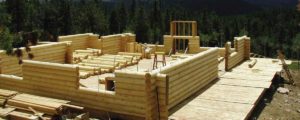Log Walls Settle
It doesn’t matter if the logs are kiln dried or dead standing, the material is made up of millions of tiny cells that were once living. As those cells continue to dry out, the logs will continue to shrink. As the logs shrink, the entire structure of the home settles down with it (provided you are using your log walls as bearing walls). This requires a number of special details and very close consideration in the design by your architect so that settling components are minimal and don’t pull apart from nonsettling components. There are systems to help mitigate it, but at the end of the day, you’re working with a material that is still alive in many respects.
The important consideration isn’t how to avoid settlement but how to handle it. Settlement is affected by the kind of wood used for the logs, conditions under which the trees were grown, the season when the logs were cut, the home’s engineering system, the construction method, and even the type of heating and cooling system used in the home.
So, there isn’t a single, simple answer. Engineering and building for settlement involve preparing for a range of possible movement.
While it is important and under certain conditions even critical, most settlement and shrinkage concerns are more for energy efficiency, maintenance time and expense, and construction quality than for structural integrity. The basic engineering of a log home makes for a strong building that can withstand a great deal of design and construction abuse.
We recommend researching best practices for log home construction based on your geographical location and home design specifics.









